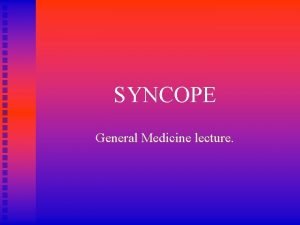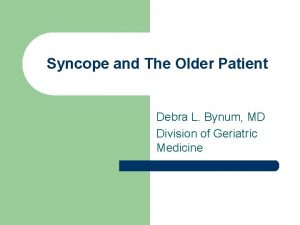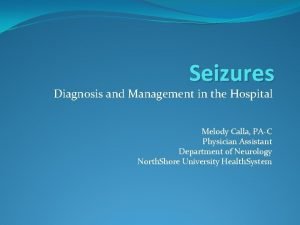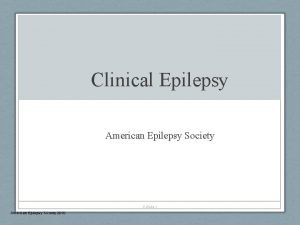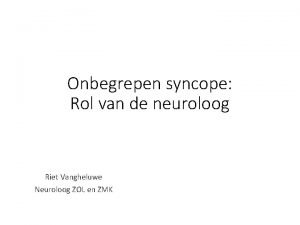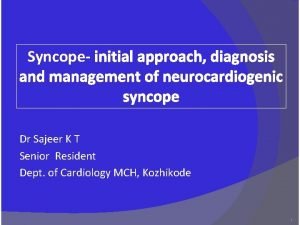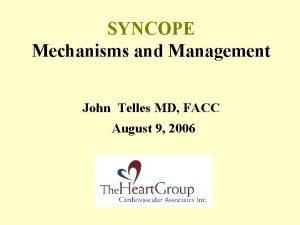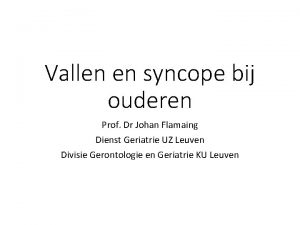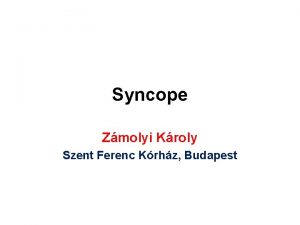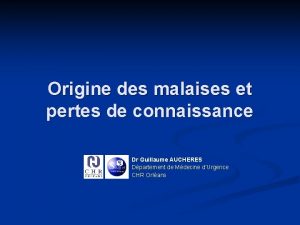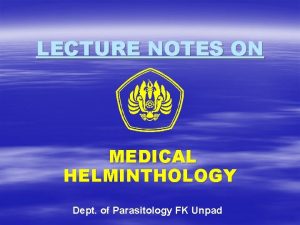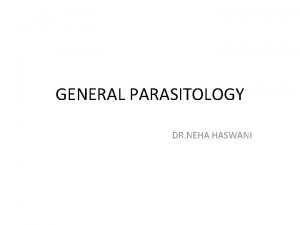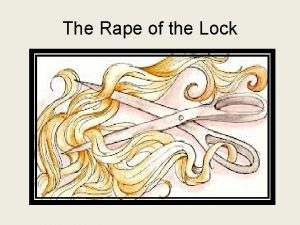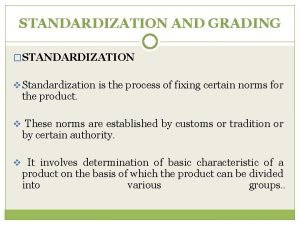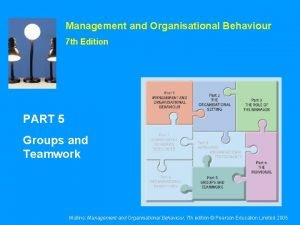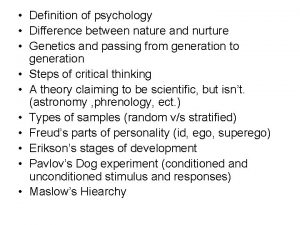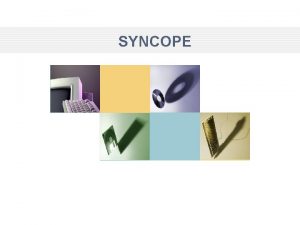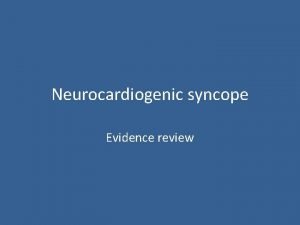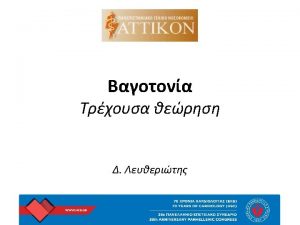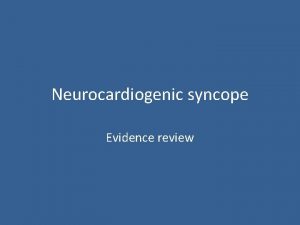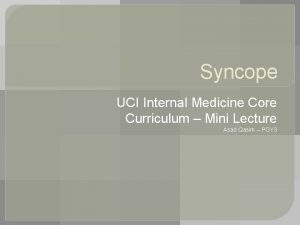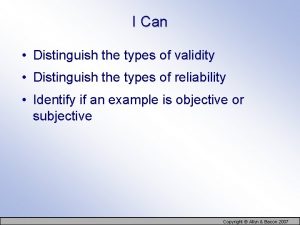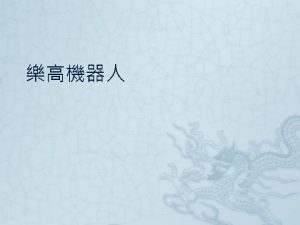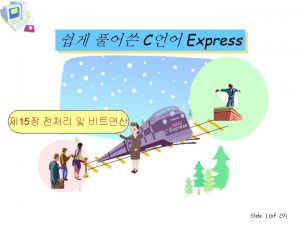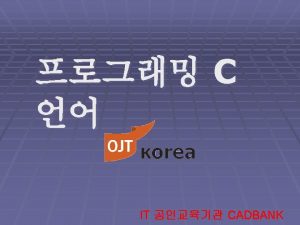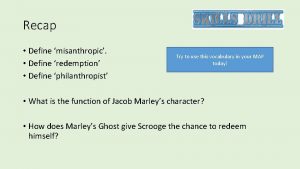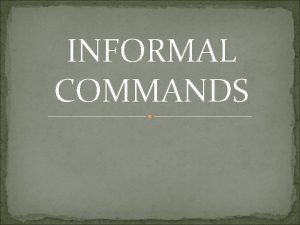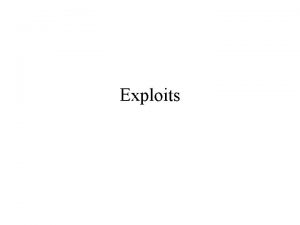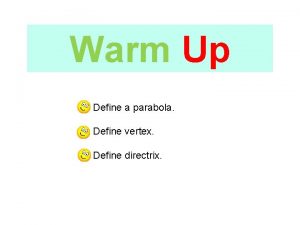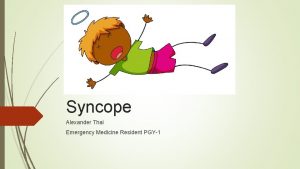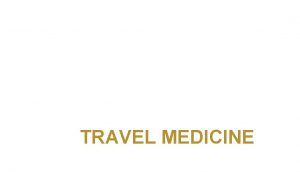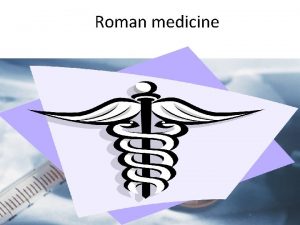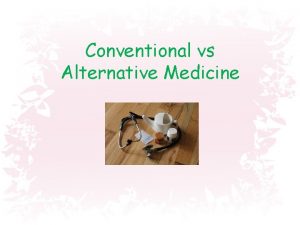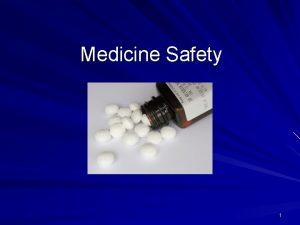SYNCOPE General Medicine lecture Outline Define syncope Distinguish






































- Slides: 38

SYNCOPE General Medicine lecture.

Outline: • • Define syncope Distinguish syncope from other symptoms Differential diagnosis Diagnose the cause of syncope Diagnostic tests Determine need for hospitalization Drug therapy

Definition: n Syncope is a sudden and brief loss of consciousness associated with loss of postural tone, from which recovery is spontaneous. n The pathophysiology of all forms of syncope consists of a sudden decrease in or brief cessation of cerebral blood flow. Associated symptoms: lightheadness, visual blurring proceding to blindness, visual spots, diaphoresis, heaviness in LE, postural sway, nausea, vomiting, pallor or ashen gray face, sense of “feeling bad”

Prevalence: n Syncope is common and it is disabling n Approximately 5 -20 % of adults will have one or more episodes of syncope by age 75 n Accounts for about 1% of hospital admissions and about 3% of emergency room visits n Annual incidence in institutionalized elderly (>75 y/o) is 6%; previous lifetime episodes is 23% (JAMA 1992; 268: 2553 -60)

Is it syncope? Distinguishing syncope from other symptoms n Dizziness, presyncope, and vertigo do not result in loss of consciousness or postural tone n Vertigo is associated with a sense of motion n “Drop attack” which is falling without warning, often due to compression of the vertebral arteries or a hyperirritable carotid sinus, occurs without loss of consciousness n The use of cardioversion to regain consciousness is by definition cardiac arrest, not syncope

Distinguishing syncope from seizure n Loss of consciousness precipitated by pain, exercise, micturition, defecation, or stressful events is usually syncope n Sweating or nausea before or during the episode are associated with syncope; an aura is typical of seizures n Rhythmic movements, e. g. clonic or myoclonic jerks, suggests seizure, (but syncope can cause movements) n Disorientation after the event, headaches, slow to return to consciousness, and unconsciousness lasting more than five minutes suggest a seizure

Differential Diagnosis Cause Prevalence (%) Neurally mediated syncope: • vasovagal attack • situational syncope • carotid-sinus syncope 18 5 1 Cardiac Syncope • organic heart disease • arrhythmia 4 14 Neurologic Disease 10 Orthostatic hypotension 8 Medications 3 Psychiatric disorder 2 Unknown (50 -66% neurally-mediated, 10 -20% psychiatric, 5% cardiac) 34 (NEJM 2000; 343: 1856 -62)

Neurally-mediated syncope (neurocardiogenic or vasovagal syncope) • • • o o o o Most common Result of reflex-mediated changes in vascular tone and heart rate Examples: emotional fainting situational syncope (e. g. in response to micturition, cough, or defecation) carotid sinus syncope Glossopharyngeal neuralgia (and other painful states) panic exercise in athletes without heart disease

Neurally-mediated Syncope (cont. ) § o o Mechanism is poorly understood emotional upset may trigger CNS fainting activation of receptors in wall of bladder, esophagus, heart, respiratory tract, and carotid sinus lead to reflex vagal efferent activity and sympathetic withdrawal § Net effect is a vicious cycle of “inappropriate peripheral vasodilitation” and “relative bradycardia” progressive hypotension and syncope (reversible by a supine posture or elevation of legs) • Possible role of neurohormonal factors (e. g. serotonin, vasopressin, endorphins, epinephrine)

Cardiac Syncope n Organic heart disease with reduced cardiac output: o Obstruction to LV outflow (e. g. aortic stenosis, hypertrophic obstructive cardiomyopathy, mitral stenosis, left atrial myxoma, ballvalve thrombus) Obstruction to pulmonary flow (e. g. pulmonic stenosis, primary pulmonary hypertension, pulmonary emboli) Myocardial: massive MI with pump failure Pericardial: cardiac tamponade Aortic dissection Reduced venous return: Valsalva maneuver o o o

Cardiac Syncope (cont. ) n Arrhythmias n Bradyarrhythmias: Atrioventricular block (2 nd or 3 rd degree) with Stokes Adams attacks Sinus bradycardia, sinoatrial block, transient sinus arrest, sick sinus syndrome Pacemaker malfunction Tachyarrhythmias: Episodic ventricular tachycardia with or without associated bradyarrhythmias Supraventricular tachycardia without AV block o o o n o o

Neurologic Diseases n Primary autonomic disturbances with CNS signs (e. g. Shy Drager syndrome, Parkinson’s Disease) or with peripheral nerve signs (e. g. GBS, and FDA) n Secondary autonomic dysfunction (e. g. chronic ethanol, diabetes) n Surgical sympathectomy n Spinal cord disorders (e. g. syringobulbia) n Posterior fossa tumors n Cerebrovascular disturbance (e. g. TIAs, vertebral-basilar or carotid insufficiency, spasm of cerebral arterioles)

Orthostatic (Postural) Hypotension § Defined as low blood pressure induced upon standing upright § Criteria: a decrease in systolic BP of >20 mm Hg, or diastolic BP > 10 mm Hg, after standing for at least 2 minutes § Causes: Volume depletion (e. g. acute illness, dehydration, GI bleeding, Addison’s disease) o o o Medications that alter vascular tone and HR Dysfunction of the vasoconstrictive reflexes in the blood vessels of the lower extremities

Medications Causing Syncope Vasodilators § Nitrates § ACE inhibitors § Ca++ Channel blockers § Hydralazine § Alpha-adrenergic blockers Psychoactive Drugs § Phenothiazines § Tricyclic Antidepressants § Barbiturates § Narcotics Diuretics Drugs associated w/ Torsades de pointes § Quinidine § Procainamide § Amiodarone § Sotalol Others § Digitalis § Insulin § Marijuana § Ethanol § Cocaine

Psychiatric disorders n Generalized anxiety disorder* Panic disorder* Major depression* Alcohol and substance abuse Hysteria Conversion disorders • predispose to neurally-mediated reaction n n

Diagnosing the Cause of Syncope n Careful history and physical exam (56 -85%) n Electrocardiography is recommended, despite low yield because it can lead to decisions about immediate treatment (5%) n Routine use of basic laboratory tests (electrolytes, blood counts, renal function, glucose level) is not recommended because of low yield; use only when specifically indicated by the H & P (2%) n This initial assessment may lead to the diagnosis

Initial Assessment Suggesting a Diagnosis n Episodes occur after sudden unexpected pain, fear, or unpleasant sight, sound, or smell n Episodes occur after prolonged standing at attention n Episodes occur in well-trained athletes without heart disease after exertion n Episodes occur during or immediately after micturition, cough, swallowing, or defecation n Vasovagal syncope n Situational syncope

Initial Assessment Suggesting Diagnosis (cont. ) n Syncope is accompanied by throat or facial pain (glossopharyngeal or trigeminal neuralgia) n n Neurally mediated syncope with neuralgia Episodes occur with head rotation or pressure on carotid sinus (tumors, shaving, tight collars) n Carotid sinus syncope n Episodes occur immediately upon standing n Orthostatic hypotension n Patients take medications that may lead to a long QT interval or orthostasis and bradycardia n Drug-induced syncope

Initial Assessment Suggesting Diagnosis (cont. ) § Syncope is associated with headaches § Patient is confused after episode, or loss of consciousnes lasts more than 5 minutes § Syncope is associated with vertigo, dysarthria, or diplopia § Episodes occur with arm exercise n Migraines, seizures n Seizure n TIA, subclavian steal n Subclavian steal

Initial Assessment Suggesting Diagnosis (cont. ) n Differences are found in BP or pulse between two arms n Subclavian steal or aortic dissection n Syncope and murmur occur with changes in position (from sitting to lying, bending, turning over in bed) n Atrial myxoma or thrombus n Syncope occurs with exertion n Aortic stenosis, pulmonary hypertension, mitral stenosis, HOCM, CAD

Initial Assessment Suggesting Diagnosis (cont. ) n Patient has a family history of sudden death n Long-QT syndrome, the Brugada syndrome n Patient has a brief loss of consciousness with no prodrome, and has heart disease n Arrhythmia n Patient has frequent syncope with no symptoms, but no heart disease n Psychiatric Illness

Importance of Heart Disease In evaluating syncope, the presence of structural heart disease is the most important factor for predicting the risk of death, and likelihood of arrhythmias. Patients with structural heart disease or an abnormal ECG have an increased risk of death in 1 year Early studies showed that cardiac causes of syncope are associated with increased mortality and an increased risk of sudden death. It was later shown that underlying heart disease, despite the cause of the syncope, is the factor associated with increased risk of death. (Ann Emerg Med, 1997; 29: 459 -66; Am J Med, 1996; 100: 646 -55)

Patients with Structural Heart Disease or ECG Abnormalities n Concern is arrhythmia n If cannot confirm structural heart disease (e. g. elderly) or syncope during exercise or known disease of undetermined severity echocardiography (5 -10%) and stress testing is recommended n 24 hour ECG monitoring is recommended as well as consultation with a cardiologist n Symptoms in conjunction with arrhythmias arrhythmia is cause n Symptoms without accompanying arrhythmia excludes arrhythmias n In the remaining patients if arrhythmic syncope is still suggested by symptoms then electrophysiologic testing and/or continuous-loop event monitoring is recommended

Patients with Normal ECG Findings and No Heart Disease n Majority of patients without heart disease have neurally-mediated syncope (includes carotid sinus syncope and psych illnesses) n Tilt table testing is recommended in patients with recurrent syncope or those with severe episodes (e. g. severe injury or MVA) or high-risk occupations (e. g. pilots) n Perform carotid sinus massage in elderly patients to rule out carotid sinus syncope (but not in those with a carotid bruit or known cerebrovascular disease) (vasodepressor > 3 sec; cardioinhibitory >50 mm. Hg fall) n If syncope and other somatic complaints consider psychiatric assessment

Testing for Arrhythmia Think arrhythmia in patients with structural heart disease or abnormal ECG if the symptoms suggest cardiac syncope (sudden brief loss of consciousness without a prodrome). n n The only way to include or exclude arrhythmia as the cause is to obtain a rhythm strip during syncope.

Ambulatory (Holter) Monitoring n Symptoms found in conjunction with arrhythmia in 4% of patients diagnosis of arrhythmic syncope n Symptoms occur without arrhythmia in 17% of patients rules out arrhythmic syncope The remaining 79% of patients either brief arrhythmias or no arrhythmias are found cannot exclude because may be episodic (Ann Intern Med 1990; 113 -53 -68) n Increasing the duration of monitoring to 72 hours does not increase the yield (Arch Int. Med 1990; 150: 1073 -78) n

Continuous–Loop Event Recorders n Provides long-term monitoring-weeks to months n Patient or an observer can activate the monitor after symptoms occur, thereby freezing in its memory the readings from the previous 2 -5 minutes and the subsequent 60 seconds n In patients with recurring syncope (> 15 episodes) arrhythmias were found during syncope in 8 -20%; normal rhythm found during symptoms in 12 -27% (Am J Cardiol 1990; 66: 214 -19; Br. Heart J. 1987; 58: 251 -253 § Limitations: compliance, potential for errors in using device, and in transmission

Electrophysiologic Studies n Yield of EP tests depends on whethere is structural heart disease or abnormal ECG Induced V. Tach Bradycardia Structural heart disease 21 % 34 % Abnormal ECG 3% 19 % Normal heart 1% 10 % (Ann Intern Med 1997; 127: 76 -86)

Tilt table Testing n Most common response in patients with unexplained syncope is sudden hypotension, bradycardia, or both n Tilt tesing is believed to provoke vasovagal syncope in susceptible persons; symptoms, hemodynamic response, and release of catecholamines are similar n ACC Guidelines on methods and indications in assessing syncope with tilt testing (JACC 1996; 28: 263 -75) n Commonly use provocative agents such as isoproterenol or nitroglycerin n The specificity of positive tilt test with chemical stimulation is near 90% (PACE 1997; 20 [Pt II]: 781 -7)

Neurologic Testing § EEG provides diagnostic information in < 2% of syncope cases § Head CT scan provides new diagnostic information in only 4 % of cases § All of these patients had focal neurologic signs or symptoms suggestive of a seizure § TIAs involving the carotid or vertebrobasilar arteries rarely result in syncope (drop attacks=vertebrobasilar ischemia) § No studies demonstrate the usefulness of cranial or carotid Doppler studies in evaluating syncope § These studies are not recommended unless the patient has neurologic symptoms or signs of a TIA

Hospitalization n For rapid diagnosis of the cause of syncope, or for treatment when the cause is known n Recommendations for hospital admission are based on the potential for adverse outcomes if evaluation is delayed (no studies that focus on this issue)

Hospitalize n 1. For diagnostic evaluation: Structural heart disease 2. Symptoms suggestive of arrhythmia or ischemia 3. 4. n 1. Examples: CAD, CHF, valves, CHD, V. arrhythmias, P. E. findings 2. Syncope w/ palpitation, chest pain, exertional syncope Electrocardiographic abnormalities 3. Ischemia, BBB, AV block, NSVT, Prolonged QT, accessory pathway, RBBB w/ ST elevation V 1 -V 3, pacemaker malfunction Neurologic Disease 4. New stroke or focal signs

Hospitalize 1. For treatment: Structural heart disease 2. Orthostatic hypotension 3. Older age n 4. Adverse drug reactions n 1. Examples: Acute MI, PE, aortic stenosis, HOCM 2. Acute, severe, volume loss, dehydration, GI bleeding; severe chronic 3. Multiple coexisting abnormalities 4. Torsades de pointes, long QT interval, anaphylaxis, orthostasis, bradyarrhythmias

OUTPATIENT Patients with neurally mediated syncope, and those who do not have heart disease or an abnormal ECG can be evaluated as outpatients

Treatment n Patients encountered during an episode should be placed in a position that will maximize cerebral blood flow n Prevent aspiration by turning head to side and give nothing by mouth until patient has regained consciousness n Don’t permit patient to arise until physical weakness has passed and patients should be observed for few minutes after rising n Avoidance of circumstances that provoke event, (e. g. excitement, fatigue, arising rapidly from bed, medications)

Treatment (cont. ) n Treat the primary disorder in structural cardiac disease, arrhythmia, or neurologic conditions n For orthostatic hypotension: volume replacement and discontinuation of inciting drugs n For autonomic failure: increase salt and fluid intake, waist high support stockings, and drugs such as fludrocortisone and midodrine

Treatment (cont. ) n In neurocardiogenic syncope (positive tilt tests) prophylaxis with betablockers or disopyramide are used. A randomized controlled study showed benefit of atenolol after 1 month (Am Heart J 1995; 130: 1250 -3) n Permanent pacemakers in those with recurrent symptoms and bradycardia on tilt table test resulted in 85% reduction in recurrent syncope (JACC 1999; 99: 1452 -7) n Paroxetine was found in a randomized, blinded, placebo-controlled study to improve symptoms in patients with vasovagal syncope unresponsive to traditional medications (JACC 1999; 33: 1227 -30)

Conclusion n Syncope is a symptom not a disease, thus evaluation focuses on physiologic states that may cause the loss of consciousness-there is no gold standard test n In evaluating syncope utilizing directed history taking and physical exams and directed diagnostic testing will lead to the diagnosis in the majority of patients n Treatment focuses on improving patient quality of life and decreasing hospital admissions
 Define distinguish
Define distinguish What is the difference between somatic and special senses
What is the difference between somatic and special senses 01:640:244 lecture notes - lecture 15: plat, idah, farad
01:640:244 lecture notes - lecture 15: plat, idah, farad Syncope in the older patient is
Syncope in the older patient is Seizure vs syncope
Seizure vs syncope Migraine aura vs seizure aura
Migraine aura vs seizure aura Prodromen syncope
Prodromen syncope Carotid sinus hypersensitivity
Carotid sinus hypersensitivity Snycope
Snycope Nursing care for pulmonary embolism
Nursing care for pulmonary embolism Syncope
Syncope Syncope
Syncope Syncope
Syncope Lecture outline example
Lecture outline example Lecture outline example
Lecture outline example Lecture outline example
Lecture outline example Lecture outline meaning
Lecture outline meaning Helminthology notes
Helminthology notes General parasitology lecture notes
General parasitology lecture notes It in a sentence
It in a sentence Family medicine definition
Family medicine definition Design elements
Design elements Proportion hairstyle
Proportion hairstyle Difference between a team and a group
Difference between a team and a group Contribution vs profit
Contribution vs profit Say what strange motive goddess
Say what strange motive goddess Distinguish between ova ovaries and ovulation
Distinguish between ova ovaries and ovulation Grading means
Grading means Irrotational flow definition
Irrotational flow definition X theory manager
X theory manager Difference between a group and a team
Difference between a group and a team Whats the difference between atomic mass and atomic number
Whats the difference between atomic mass and atomic number Difference between health education and propaganda
Difference between health education and propaganda Good afternoon to everyone
Good afternoon to everyone Octane and cetane number
Octane and cetane number Renal corpuscle
Renal corpuscle Difference between entrepreneurs and managers
Difference between entrepreneurs and managers Aniline point
Aniline point Nurture psychology definition
Nurture psychology definition
